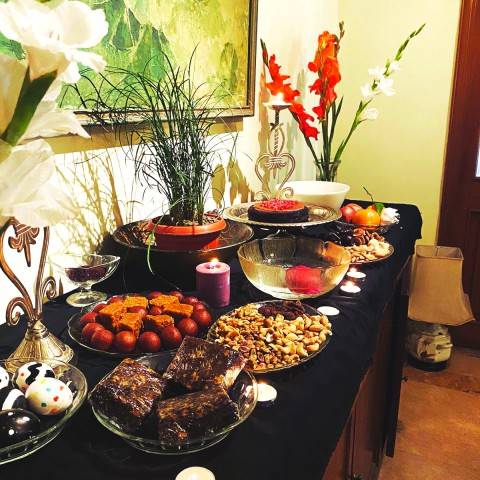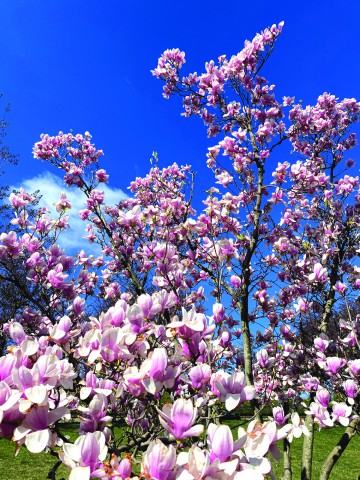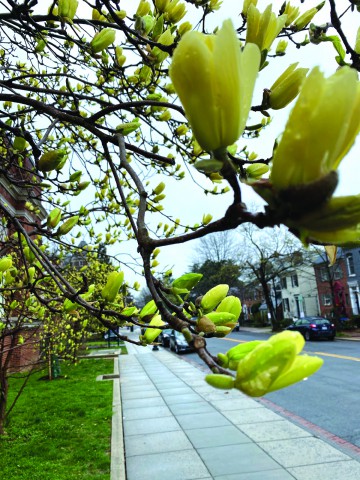
Spring brings with it a sense of rejuvenation and renewal in humans and nature. How can it not? It is a time to celebrate re-birth, an Easter Egg containing the future.
As I write this, outside my window in Washington DC, cherry blossom trees are bursting with pink exuberance in the morning sunshine. Squirrels tired of the frugality of winter scamper amongst the branches of trees coming alive with fresh shoots.
Fortuitously, this year, the festivals of Islamic Shab-e-Barat, the Jewish Passover, Christianity’s Palm Sunday, Holi for the Hindus and Nowruz for those of Iranian persuasion are being celebrated within the same fortnight in March. Different cultures and religions unite in celebrating the advent of spring – celebrating light, colour, optimism and wishes that prayers come true.
I received a lovely gift from a friend the other day – a Rumi poem and some seeds to plant. It was for Nowruz – the Persian “new day” marking the first day of spring. Iranians assemble a ‘haft sin’ table, haft being the seven elements beginning with S – sabzeh, senjed, sib, seer, sabanu, serekh and sumac. These together are symbolic of the qualities of promise, wisdom and celebration.

Sabzeh in particular is a kind of green grass symbolizing regeneration and rebirth. One does not have to be religious to grow or sprout seeds - they are nature in motion.
Nowruz has a special meaning for me, because my maternal family celebrates Nowruz at the Equinox each year to honour their Persian-speaking heritage. I commemorate Shab-e-Barat for being the night when an individual’s fortune is decided by Allah – a night when one can ask for forgiveness and to honour one’s deceased ancestors. It is celebrated across many countries in the Islamic world. In Turkey, it is referred to as “Berat Kandili” similar to the Persian word for ‘cheragh’ or light. In essence, the luminous quality of light and removal of darkness is common to this tradition. As part of Kurdish and Irani culture, it is also linked to respecting the souls of the dead with humility and reverence.
Interestingly, on the other side of the world, a similar tradition exists. A couple of years ago I had visited Isla Muejeres -The Island of Women off the coast of the Mexican Yucutan coast. There a local faith healer at the southern-most tip of the island performed a ceremony dedicated to Ixchel, the Mayan goddess of the moon, fertility, medicine and happiness. Devotees threw seeds into the grassy cliffs overlooking the azure Caribbean - to invite her largesse and to gain strength from her wisdom.

Geographically, this was a point that has guided sailors since the fifteenth century. The Island is still celebrated for its feminine powers and to pray at this tip of the island is meant to signify birth and renewal.
Closer to the Middle East, Passover the Jewish tradition also has its origins linked the counting of the Omer and is connected to the barley harvest in spring. Lamb was sacrificed, offered and eaten on Passover evening. Its origins also celebrate the ceremony of unleavened bread, to commemorate how the Israelis left Egypt in such a hurry that they could not even wait for their bread to leaven.
Such reminders are maintained even unto today. This has parallels to the Christian tradition of using wafers of unrisen bread for communion as a symbol. One could go down an entire rabbit hole of exploring the different cultural traditions of unleavened bread – whether the tortilla in Mexico, the lavash in Amenia or closer to home, the chapati.
Even Palm Sunday in the Christian tradition is linked to the blessing and procession of palms, linked to Lent and the spring Equinox, though also celebrating Jesus’s first step towards his death.

Underlying all these rituals, whether religious or cultural is the recognition that one can pray for forgiveness, that past sins can be wiped out and with enough humility and reverence, one can begin again. It is aligned with the earth tilting towards the sun, the promise of more day light and longer days – bringing with it the concept of luminosity of light.
Unsurprisingly, eggs are also the symbol whether painting in turmeric and beet colours to celebrate Nowruz or in Easter colours to mark the passage of spring. Even in ancient Chinese culture, there is folklore that one can stand a raw egg on its end for Equinox; an experiment I would highly recommend to those of you with young children.
With so much magic, myth and folklore associated with spring and the Equinox, it is hard not to celebrate the advent of spring. For, as Rumi aptly put it, “The outward spring and garden are a reflection of the inward garden.” And as spring comes our way this year, I would urge you to spend time throwing out the evil from last year and planting something green to cultivate your own inner garden.
As I write this, outside my window in Washington DC, cherry blossom trees are bursting with pink exuberance in the morning sunshine. Squirrels tired of the frugality of winter scamper amongst the branches of trees coming alive with fresh shoots.
Fortuitously, this year, the festivals of Islamic Shab-e-Barat, the Jewish Passover, Christianity’s Palm Sunday, Holi for the Hindus and Nowruz for those of Iranian persuasion are being celebrated within the same fortnight in March. Different cultures and religions unite in celebrating the advent of spring – celebrating light, colour, optimism and wishes that prayers come true.
I received a lovely gift from a friend the other day – a Rumi poem and some seeds to plant. It was for Nowruz – the Persian “new day” marking the first day of spring. Iranians assemble a ‘haft sin’ table, haft being the seven elements beginning with S – sabzeh, senjed, sib, seer, sabanu, serekh and sumac. These together are symbolic of the qualities of promise, wisdom and celebration.

Sabzeh in particular is a kind of green grass symbolizing regeneration and rebirth. One does not have to be religious to grow or sprout seeds - they are nature in motion.
Nowruz has a special meaning for me, because my maternal family celebrates Nowruz at the Equinox each year to honour their Persian-speaking heritage. I commemorate Shab-e-Barat for being the night when an individual’s fortune is decided by Allah – a night when one can ask for forgiveness and to honour one’s deceased ancestors. It is celebrated across many countries in the Islamic world. In Turkey, it is referred to as “Berat Kandili” similar to the Persian word for ‘cheragh’ or light. In essence, the luminous quality of light and removal of darkness is common to this tradition. As part of Kurdish and Irani culture, it is also linked to respecting the souls of the dead with humility and reverence.
Underlying all these rituals, whether religious or cultural, is the recognition that one can pray for forgiveness, that past sins can be wiped out and with enough humility and reverence, one can begin again
Interestingly, on the other side of the world, a similar tradition exists. A couple of years ago I had visited Isla Muejeres -The Island of Women off the coast of the Mexican Yucutan coast. There a local faith healer at the southern-most tip of the island performed a ceremony dedicated to Ixchel, the Mayan goddess of the moon, fertility, medicine and happiness. Devotees threw seeds into the grassy cliffs overlooking the azure Caribbean - to invite her largesse and to gain strength from her wisdom.

Geographically, this was a point that has guided sailors since the fifteenth century. The Island is still celebrated for its feminine powers and to pray at this tip of the island is meant to signify birth and renewal.
Closer to the Middle East, Passover the Jewish tradition also has its origins linked the counting of the Omer and is connected to the barley harvest in spring. Lamb was sacrificed, offered and eaten on Passover evening. Its origins also celebrate the ceremony of unleavened bread, to commemorate how the Israelis left Egypt in such a hurry that they could not even wait for their bread to leaven.
Such reminders are maintained even unto today. This has parallels to the Christian tradition of using wafers of unrisen bread for communion as a symbol. One could go down an entire rabbit hole of exploring the different cultural traditions of unleavened bread – whether the tortilla in Mexico, the lavash in Amenia or closer to home, the chapati.
Even Palm Sunday in the Christian tradition is linked to the blessing and procession of palms, linked to Lent and the spring Equinox, though also celebrating Jesus’s first step towards his death.

Underlying all these rituals, whether religious or cultural is the recognition that one can pray for forgiveness, that past sins can be wiped out and with enough humility and reverence, one can begin again. It is aligned with the earth tilting towards the sun, the promise of more day light and longer days – bringing with it the concept of luminosity of light.
Unsurprisingly, eggs are also the symbol whether painting in turmeric and beet colours to celebrate Nowruz or in Easter colours to mark the passage of spring. Even in ancient Chinese culture, there is folklore that one can stand a raw egg on its end for Equinox; an experiment I would highly recommend to those of you with young children.
With so much magic, myth and folklore associated with spring and the Equinox, it is hard not to celebrate the advent of spring. For, as Rumi aptly put it, “The outward spring and garden are a reflection of the inward garden.” And as spring comes our way this year, I would urge you to spend time throwing out the evil from last year and planting something green to cultivate your own inner garden.

